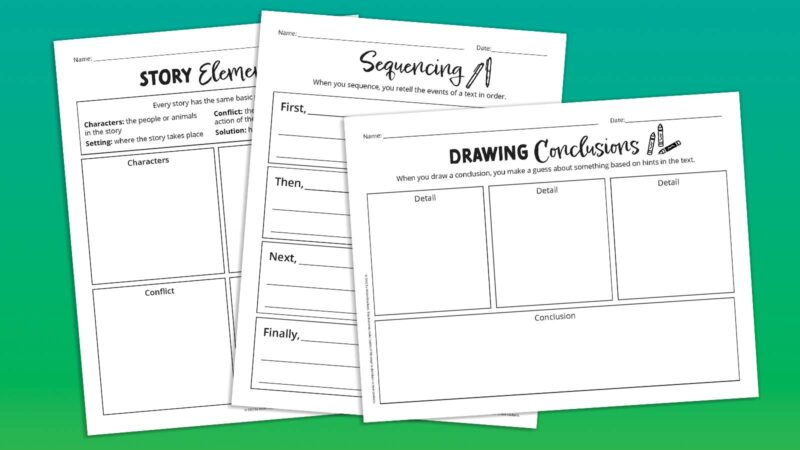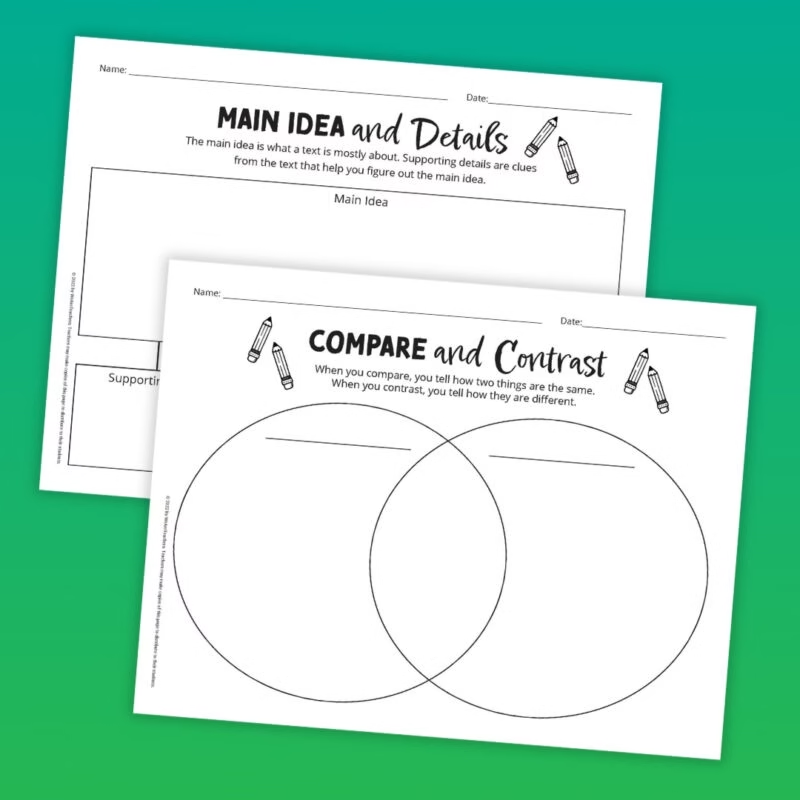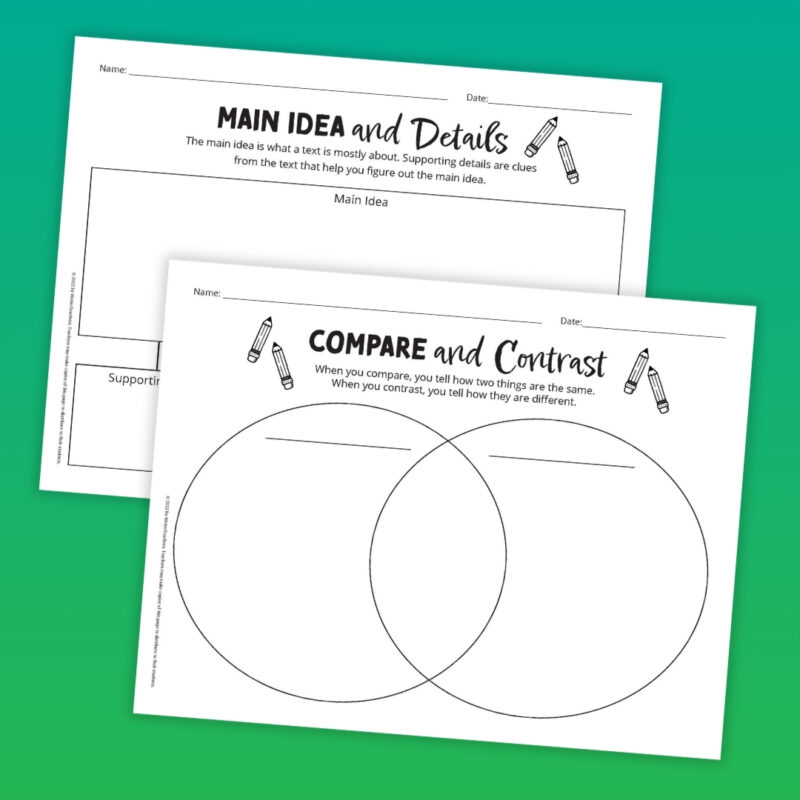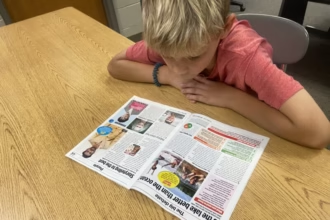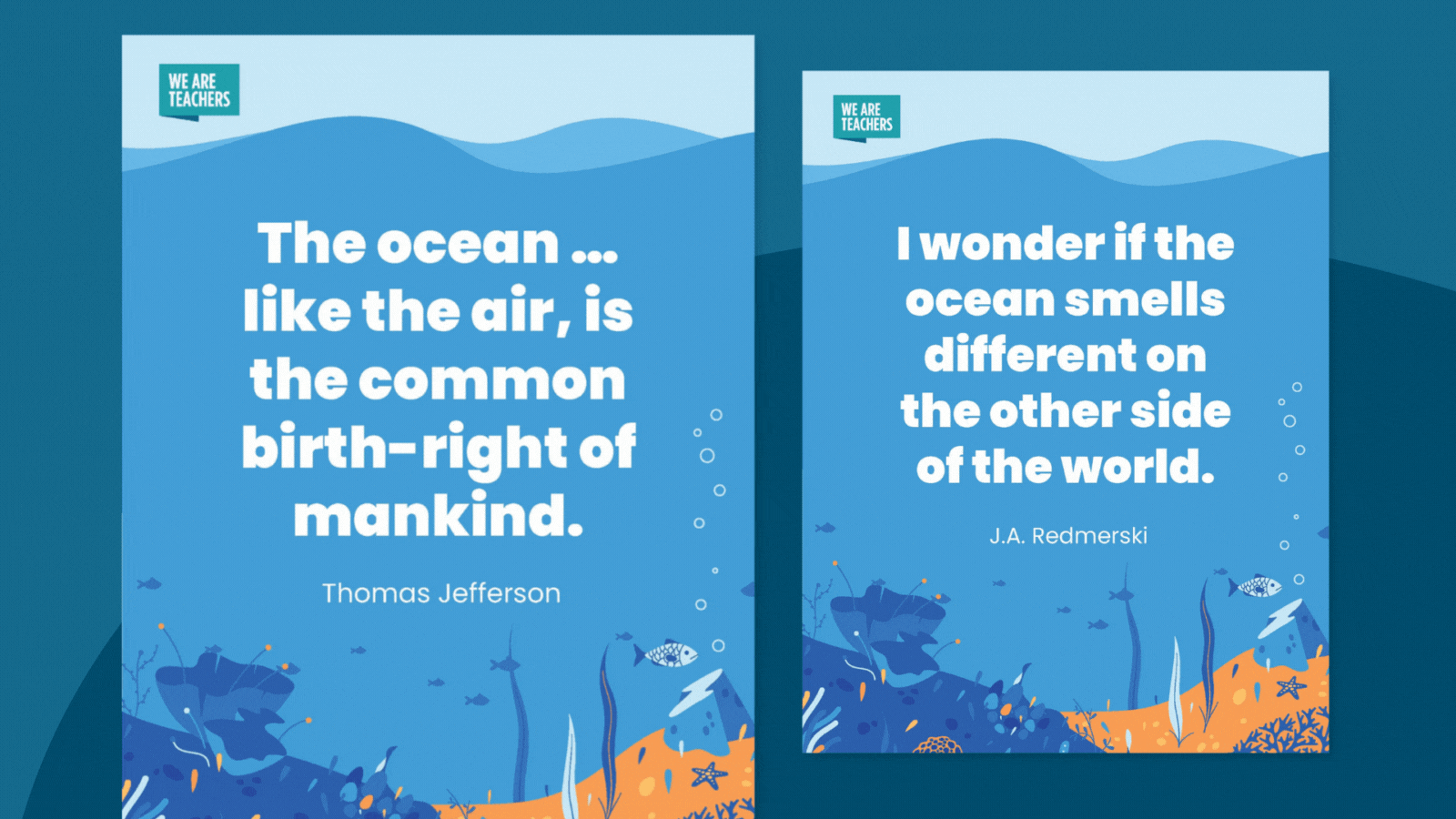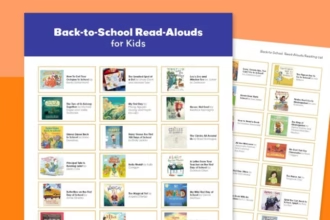Experienced teachers know that true literacy is much more than just being able to sound out the letters on the page. Skilled readers need to be able to master both what the words are and what they mean. To do this successfully, they bring together various skills like vocabulary, language structure, and verbal reasoning. Scarborough’s Reading Rope is one well-known model that can help educators better understand what it truly takes to create skilled readers.
Jump to:
What is Scarborough’s Reading Rope?
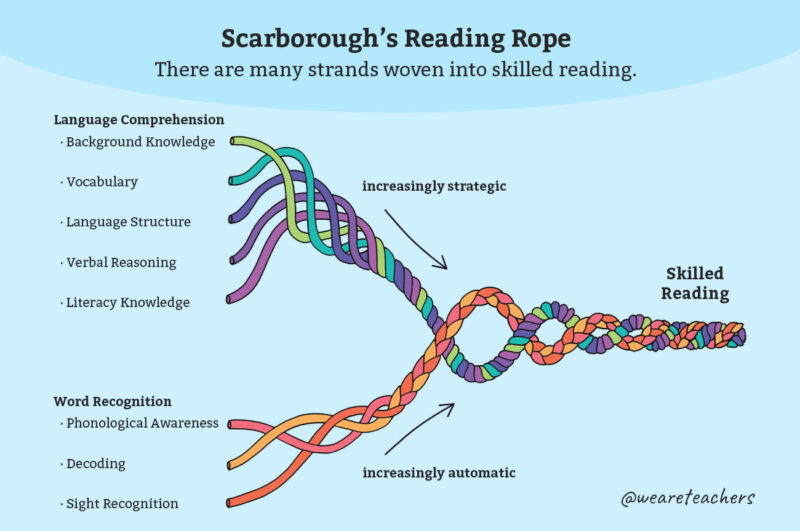
Scarborough’s Reading Rope is a visual model that shows how skilled reading is made up of many different skills working together. It combines word recognition (phonological awareness, decoding, and sight recognition) with language comprehension (background knowledge, vocabulary, language structure, verbal reasoning, and literacy knowledge). Each of the strands, usually shown in different colors, represents one of these key skills, and together they contribute to a strong “rope” of reading fluency.
Dr. Hollis Scarborough invented the concept of the Reading Rope in the early 1990s. She used it to help parents understand the various skills their children needed to master to become proficient readers. Originally, she twisted together a model made of pipe cleaners to demonstrate her point.
In 2001, the model was published in the Handbook of Early Literacy Research (Neuman/Dickinson). Reading teachers immediately saw how useful it was, and it became a staple for educating new teachers and parents alike.
Scarborough’s Reading Rope contains two main sections: Word Recognition and Language Comprehension. Each of these comprises several smaller strands. Woven together, these strands become the rope that represents complete skilled reading. All the components are interconnected and interdependent. If just one strand is weak, it affects the rope (and the reader) as a whole.
Lower Section: Word Recognition Strands

The lower section of Scarborough’s Reading Rope focuses on word recognition skills. These are the skills we tend to think of first when we talk about teaching kids how to read. Imagine a kid sounding out the letters on a page or putting together phonics sounds and syllables. Here’s a look at the components of word recognition.
Phonological Awareness
Put simply, phonological awareness is about understanding that spoken words are made up of sounds. Kids learn to speak without ever needing to see a written word. But when they learn reading, they need to recognize that the sounds they make with their mouths correspond with the words they see on the page. Phonological awareness is the ability to hear and work with spoken sounds that sets the stage for reading and writing.
Learn more: What Is Phonological Awareness?
Decoding
Decoding is what we picture when we think of beginning readers: kids using the sounds of letters to read words. As kids get better at decoding, they use their understanding of phonics patterns like blends, digraphs, silent letters, and vowel teams to read words. Kids proficient at decoding can efficiently “sound out” all the unfamiliar words they see on a page, even if they don’t know what the words mean.
Learn more: Effective Decoding Strategies and Activities for Emerging Readers
Sight Words / Sight Recognition
Orthographic mapping—the brain’s process for recognizing and permanently storing words—allows readers to build a rapidly growing bank of “sight words,” or words they recognize automatically without having to decode them. It’s generally accepted that directly teaching kids some of the most common sight words as early readers, especially ones that use phonics patterns they haven’t learned yet, gives them a leg up when learning to read.
Learn more: What Are Sight Words?
Upper Section: Language Comprehension Strands

Word recognition on its own doesn’t create fluent readers. If kids don’t know what the words themselves mean, they’re not really reading. Fluent readers understand the text they’re reading as a whole, drawing meaningful conclusions and finding important takeaways. The upper strands of Scarborough’s Reading Rope are incredibly key in creating strong readers, and they should be taught at the same time as (and even earlier than) word comprehension skills.
Background Knowledge
Background knowledge, or everything a reader already knows, impacts their understanding of what they read. Kids reading a novel set in World War II Germany will get a lot more out of it when they understand more about WWII in general. For teachers, this means placing reading choices in context across the entire curriculum. Use reading (at any age) as part of a larger lesson on any topic. Kids will develop a deeper understanding and improve literacy skills at the same time.
Learn more: How To Build Background Knowledge
Vocabulary
Building a rich vocabulary means kids can enjoy reading a wider variety of books. When you have to stop every few sentences to figure out what a word means, you’re likely to give up on reading a lot faster. Even worse is when kids don’t stop, since they’ll have “read” something without understanding it fully—or at all. Vocabulary development happens both orally and in reading. The best vocabulary teaching both boosts the number of words kids know and how well they know those meanings—for instance, understanding how a word like “curious” can be used in different contexts to mean inquisitive or peculiar.
Learn more: Vocabulary Activities for Kids
Language Structure
When we talk about language structure, we generally mean syntax (the order of words) and grammar rules, and semantics (the meaning of the text). English has a lot of rules for the patterns and order of words, known as syntax. Semantics delves deep into how words and phrases combine to create meaning and how an author’s word choice affects that meaning. It’s a complicated topic, which good readers continue to consider throughout their lives.
Learn more: 14 Important English Grammar Rules
Verbal Reasoning
When it comes to Scarborough’s Reading Rope, verbal reasoning helps all readers make sense of what they read and learn to “read between the lines.” It goes beyond understanding the literal meaning of the words themselves—verbal reasoning helps us draw conclusions, make predictions, and understand cause and effect. It includes concepts like context, inference, figurative language, and more. A child with strong verbal reasoning can connect ideas, spot relationships between words, and use language to reason through challenges.
Verbal reasoning is closely linked to metacognition—learn more here.
Literacy Knowledge
This strand starts early, as children learn that printed letters correspond to spoken words (print awareness). They also begin to comprehend the structure of sentences, paragraphs, and stories. As they grow, kids expand their literacy knowledge by exposure to a wide array of literary genres and styles. This is why a strong curriculum covers fiction, nonfiction, and poetry in all their forms. Generally speaking, the more types of reading a child encounters, the more advanced their literacy knowledge becomes.
Learn more: 50+ Literary Genres and Subgenres
Importance of Scarborough’s Reading Rope
Anyone who teaches language arts at any level should be familiar with this key symbol of true reading comprehension. The Reading Rope isn’t just about emergent readers—it represents the interwoven abilities readers of all ages need to truly understand and connect with what they read. Here’s why Scarborough’s Reading Rope matters to all language teachers:
The Reading Rope supports the science of reading.
Scarborough’s Reading Rope is one of the most popular models to help people visualize what’s known as “the science of reading.” While all students learn a little differently, the science of reading provides instructional strategies that work with nearly every child. It encompasses decades of reliable research that has identified the best ways to teach and learn how to read. The National Reading Panel identifies these five elements of fluent reading: phonemic awareness, vocabulary, fluency, phonics, and comprehension. All of these are represented in the Reading Rope model.
Scarborough’s Reading Rope breaks down the complexity of reading in an accessible manner.
Teachers can (and should) share this model with parents. It can help them understand that while reading is partly about “sounding out the words,” it’s also about much more. It can explain where their child is struggling or why teachers use such a variety of methods in the classroom. It’s also a good tool to reinforce that reading at home is essential to building the literacy skills kids need in school and throughout their lives.
The Reading Rope helps promote early intervention for struggling readers.
Looking at the details of the Reading Rope can help teachers identify where struggling readers may need more help. For instance, a student may be very good at sounding out the words on the page but lack the vocabulary or verbal reasoning to make sense of what they’re reading. Once they identify the weak strands, a teacher can make adjustments or offer enrichment to help that student succeed.
Scarborough’s Reading Rope can guide effective instruction at every grade level.
Teachers can and should use the Reading Rope to look at the big picture of their literacy curriculum to make sure they’re providing kids with instruction in all the necessary areas. As kids get older, it’s especially important to incorporate all the strands of the upper section of the rope. Language comprehension is complex, including more than just a robust vocabulary. Secondary teachers can ensure good reading fluency and comprehension by focusing on verbal reasoning and background knowledge in addition to language structure topics (like grammar and syntax).
In 2024, literacy professors Anna Kambach and Heidi Mesmer reexamined the value of the various strands of the Reading Rope in an article for The Reading Teacher. They discovered that many teachers don’t fully understand some parts of the rope. Specifically, they noted that early childhood educators often focused on the lower strands like decoding and sight words without incorporating the upper strands like verbal reasoning or language structure. (Some teachers even expressed confusion as to the meaning of those terms.) Kambach and Mesmer urged literacy teachers to broaden their focus to encompass all strands of the rope from the earliest ages. Learn more about their research, discoveries, and recommendations here.
Scarborough’s Reading Rope FAQs
What is the definition of Scarborough’s Reading Rope?
The Reading Rope is a model showing how skilled reading depends on many interwoven skills, made up of both word recognition (being able to sound out words or recognize them on sight) and language comprehension (fully understanding and connecting with the text). It’s represented by a rope of colorful interwoven strands, each an important part of the model.
What are the strands of Scarborough’s Reading Rope?
The Reading Rope is broken into two sections, each with its own individual strands:
Word Recognition Reading Rope Strands (Lower):
- Phonological Awareness
- Decoding
- Sight Recognition
Language Comprehension Reading Rope Strands (Upper):
- Background Knowledge
- Vocabulary
- Language Structure
- Verbal Reasoning
- Literacy Knowledge
Why is it called a “rope”?
It’s called a “rope” because the model shows reading skills are like strands twisted together—each skill adds strength, and together they form a strong foundation for fluent reading. Dr. Hollis Scarborough originally twisted colored pipe cleaners together to use her model to explain reading fluency to parents.
How does Scarborough’s Reading Rope help teachers and parents?
The Reading Rope breaks reading into clear parts so adults can identify what a child needs help with and support both decoding and comprehension skills. It can also help teachers plan and refine their curriculum to ensure students receive a strong grounding in all the interwoven skills of the rope.
Is Scarborough’s Reading Rope only for early readers (elementary school)?
No! The Reading Rope is useful for all ages, with language comprehension skills becoming especially important as texts get more complex. However, elementary school teachers shouldn’t neglect language comprehension—while emergent readers often focus heavily on word recognition (decoding and sight words), language comprehension abilities are essential for ensuring kids truly understand what they read.
How does Scarborough’s Reading Rope relate to the science of reading?
The Reading Rope visually represents key research showing that effective reading requires both decoding skills and language comprehension, which are central to the science of reading. Learn more about the science of reading here.
Don’t forget to download your free Reading Comprehension Strategies worksheet bundle!
